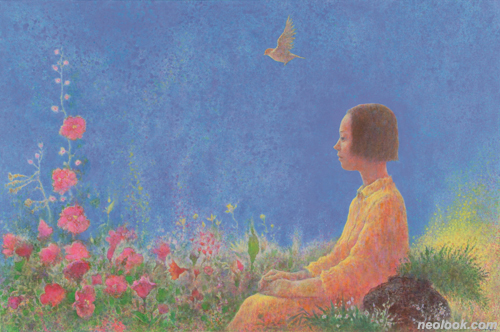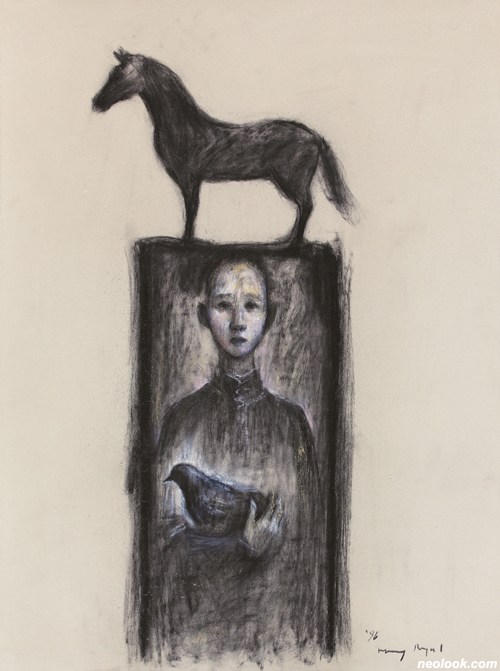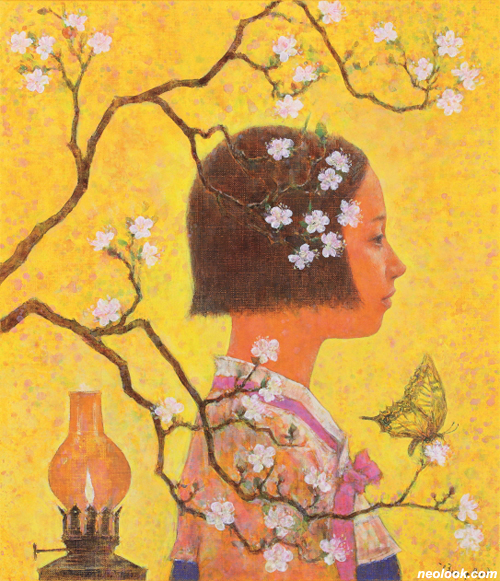- ● homepage
- ● archives
- ● restoration
- ● books
- ● big banners
- ● post board
- ■ neo's search
- ■ about us
- ■ 게재방법 안내
- 개인정보처리방침

- [email protected]
- Tel. 02_335_7922
- Fax. 02_335_7929
- 10:00am~04:30pm
- 월요일~금요일
- 3/3(월) 대체공휴일

A DREAM DRANCHED WITH DAWN
박항률展 / PARKHANGRYUL / 朴沆律 / painting 2013_1206 ▶ 2014_0104
● 위 이미지를 클릭하면 네오룩 아카이브 Vol.20101105i | 박항률展으로 갑니다.
작가와의 대담 / 2013_1206_금요일_05:00pm
박항률 화백, 정호승 시인과의 대담
관람시간 / 10:00am~07:00pm
가나아트 부산 GANA ART BUSAN 부산시 해운대구 중동 1405-16번지 노보텔 앰배서더 부산 4층 Tel. +82.51.744.2020 www.ganaart.com
인간 내면의 고독한 아름다움 ● 나는 때때로 박항률 화백의 그림 속 인물이 되고 싶다. 박화백의 그림 속에 있는 인물을 볼 때마다 혹시 내가 저 그림 속에 있는 게 아닌가 하는 생각이 들 때가 한 두 번이 아니다. 그러다가 그만 내가 박화백의 그림 속에 고요히 앉아 있다고 생각하고 적인 행보해질 때가 있다. ● 어느 봄날의 가장 아름다운 날, 꽃들이 만발한 산속에서 꽃바구니를 무릎 위에 얹어놓고 엷은 미소를 띠고 있는 한 소녀의 모습은 어쩌면 전생의 나 자신인지도 모른다. ● 어디 소녀뿐이랴. 비둘기를 가슴에 안고 있는 한 소년의 모습을 보면, 마치 내가 비둘기를 꼭 껴안고 그 동안 아무한테도 말 하지 못했던 내 삶의 이야기를 그 비둘기에게 고백하고 있는 듯하다.

- 박항률_응시 A Stare_종이에 아크릴채색_77.5×72cm_2013
박화백의 그림에는 꽃과 새가 많이 등장한다. 그는 이 세상의 많은 꽃들 중에서 매화를 가장 많이 그린다. 아마 매화가 지닌 고매한 인고의 순결성을 닮고 싶기 때문일 것이다. 그는 꽃의 특징을 섬세하게 살려가며 그린다기보다 꽃의 이미지만을 가지고 그린다. 그래서 그의 화폭에서 피어난 꽃들은 모든 은유의 꽃이다. ● 나는 박화백의 그림 중에서 젊은 여인의 머리 위에 작은 새 한 마리가 고요히 앉아 있는 모습을 보면 늘 숨이 딱 멎는다. 인간의 머리 위에 앉아 있는 저 새는 바로 내 영혼의 구체적 모습이다. 만일 내 영혼의 모습이 날카로운 돌멩이거나 구겨진 지폐라면 그 얼마나 부끄러운가. 내 영혼이 한 마리 새가 되기 위해서는 현실적인 오늘의 내 삶이 맑고 순결해야 하나 그렇지 못해서 박화백의 그림 앞에서 늘 내 심장은 멎는다. ● 나는 또 박화백의 그림 속 인물과 새가 서로 한없이 바라보고 있는 모습을 보면, 도대체 저 새와 소녀가 무슨 이야기를 나누고 있는지 궁금해서 견디지 못한다. 그래서 잔뜩 귀를 기울이며 나 나름대로 무한한 상상의 대화를 엿듣는다. 그러다가 그만 내가 그림 속의 인물이 되어 그 새와 이야기를 나눌 때도 있다. 한번은 나도 모르게 그 새에게 "난 너를 사랑해!"하고 말한 적도 있다.

- 박항률_꽃그늘 The Shade of Flowers_캔버스에 아크릴채색_97×145cm_2012
박화백에게 새는 인간 영혼의 존재다. 그는 "사람과 가장 가깝고 친근한 새이기 때문에" 참새와 비둘기를 가장 많이 그린다. 프랑스 파리에 갔을 때 노트르담 성당에서 모이를 가진 한 중년남자 주변으로 새들이 모여드는 모습을 보고 그는 인간과 새가 서로 소통할 수 있다는 것을 깊이 깨닫게 되었다. 또 이탈리아 베네치아의 산 마르코 성당 중앙광장에서 비둘기떼들이 인간과 하나가 되어 아름다운 풍경을 이루는 것을 보고 인간과 새의 영혼이 서로 교감하는 일체된 모습을 그리게 되었다. ● 박화백이 새를 그리게 된 것은 대학생 때부터다. 처음에는 새가 알을 품고 있는 형상을 많이 그렸다. 헤르만 헤세의 소설 『데미안』에 나오는 구절, "새는 알을 깨고 나온다. 알은 새의 세계다. 태어나려고 하는 자는 한 세계를 파괴하지 않으면 안 된다"는 구절에서 대학생 박항률은 '참나'를 찾아가는 구도적 자기 탐구의식이 발로되었다. 알을 깨고 나온 새의 모습이 바로 자신의 내면의 모습이라는 그러한 인식은 지금도 그의 그림에서 주조를 이룬다. ● 박화백은 "인물의 내면을 표현하기 위해 새를 많이 그린다"고 말한다. 이 말은 바로 박화백이 그림으로 드러내고 싶은 자신의 내면의 존재를 드러낸다는 말이다. "새와 꽃은 내 인생의 동행자이자 동반자의 의미를 지닌다"는 그의 말 또한 자연적 존재야말로 인간이 동반할 수 있는 가장 이상적인 존재라는 것을 의미한다. ● 그래서일까. 그의 새는 항상 인물이나 사물의 끝에 앉아 있다. 그는 인물의 머리 위나 손가락 끝에, 또는 나뭇가지 끝에 앉아 있는 새를 그린다. 심지어 한 마리 나비나 잠자리조차 대금이나 풀잎의 끝에 앉아 있게 한다. 왜 그럴까. 그러한 가장자리의 세계, 끝의 세계, 그 절정의 세계는 무엇을 의미하는 것일까. 박화백은 지상과 천상의 세계를 이어주는 역할을 하는 "솟대 끝에 앉아 있는 새의 이미지를 빌려온 것"이라고 하지만, 나는 그것을 인간 고독의 극단을 의미하는, 절대고독의 세계라고 말하고 싶다.

- 박항률_꿈꾸는 달 The Dreaming Moon_종이에 연필, 목탄, 아크릴채색_40×25.6cm_2012
박화백은 인물을 그리되 여러 사람을 그리지 않는다. 그의 그림에 군상(群像)은 등장하지 않는다. 그의 화폭에는 항상 단 하나의 인물만 등장한다. 이점에 대해 그는 이렇게 말한다. ● "사람을 그린다는 것은 결국 자기 자신을 그린다는 것이다. 그림 속에 보이는 인물은 다른 사람을 모델로 그리는 것 같지만 실은 나를 그리는 것이다. 내 존재에 대한 다양성을 드러내고 비쳐본다고 할 수 있다. 따라서 내 속에는 소년도 있고 소녀도 존재한다. 그림 속의 인물이 조용히 앉아 있지만 실은 그런 것은 아니다." ● 그의 그림 속의 '고요한 동적(動的) 인물'에서 나는 외로움보다는 고독을 느낀다. 그의 인물은 항상 고독한 존재다. 고독은 상대적이고 사화적 의미를 지니는 외로움과 달리 절대적이고 존재적 의미를 지닌다. 절대자와 인간인 나라는 존재 사이에서 느껴지는 마음의 부분, 그런 절대고독의 모습이 그의 그림 속 인물의 모습이다.

- 박항률_소년과 비둘기 A Young Boy with a Dove_종이에 아크릴채색_101×72cm_2012
오늘은 "사람은 때때로 홀로 있을 줄 알아야 한다"는 법정 스님의 말씀을 그의 그림 속 인물을 통해 묵상해본다. 절대고독의 영역에 있을 수 있는 자만이 진정 자신을 사랑할 수 있고 또 남을 사랑할 수 있는 것이라고 성찰해본다. ● 인생은 어느 순간에 가장 아름다워지는가. 자연 속에서 자연과 하나가 되어 고독한 성찰의 세계에 머물 때 가장 아름다워진다. 박화백의 그림 속에 앉아 자연과 하나가 될 때 나는 가장 아름다운 인생의 순간을 살게 된다. 박화백의 그림을 많은 이들이 좋아하고 사랑하는 까닭은 바로 그림 속의 인물과 내가 하나가 됨으로써 아름다워지기 때문이다. ● 박화백은 "내가 그림 속의 인물을 보기도 하지만, 그림 속의 인물 또한 나를 보고 있다"고 한다. 이는 객체와 주체의 경계가 사라짐으로써 고독한 영혼의 교감을 통해 서로 영원한 일체감을 형성한다는 말이다. 그래서 그는 "그림에서든 조각에서든 내 작품이 자기 자신을 들여다보는 매개체가 되기를" 바란다. ● 오늘 나는 박화백의 그림 속의 인물과 내가 하나가 된다. 현생의 삶을 사는 나는 지금 이 순간이 기쁘다. 특히 이번 부산 개인전에서는 박화백의 청년기 때 그림과 평소 보기 힘들었던 조각까지 볼 수 있어서 더욱 기쁘다. ■ 정호승

- 박항률_비밀 이야기 The Secret Story_종이에 목탄, 파스텔_76×56.5cm_1996

- 박항률_生卽是夢 Life is a Dream_종이에 연필_20.5×49.5cm_2009
Solitary Beauty Within the Human Mind ● I often wish I can be a figure in paintings by Park Hang-Ryul. Whenever I look into Park's subjects, I have the sensation that I am inside the paintings with them. Then I am completely drawn into the artwork, imagining myself sitting quietly in one of his paintings. ● It is one of the most beautiful spring days, and a girl sits in a mountain forest filled with flowers in full bloom, with a flower basket on her lap and a faint smile on her lips. She could be me from my past life. ● There are other engaging characters. A boy holding a dove close to his chest seems as if he is confiding in the bird the story of my life that has never been told. ● Flowers and birds often appear in Park's paintings. Of all the flowers in the world, plum blossoms are most often his choice, perhaps because of his wish to resemble the pure integrity of their noble patience. Rather than portraying the smallest details, Park simply works with the general image of the flowers. This means all flowers that blossom in his canvas are flowers of metaphor. ● The painting of a young woman who sits quietly with a small bird on her head always takes my breath away. That bird on a human head represents a human soul. How embarrassing it would be, if my soul took the form of a sharp stone or a wrinkled banknote. For my soul to become a bird, the life I lead today in the real world should be clear and pure. However, my heart skips a beat every time I stand before this painting, knowing my life is not so. ● In another painting, a girl and a bird seem lost, gazing into each other's eyes. I cannot help but wonder what the two are sharing with each other. I listen in with all my heart and start to eavesdrop on an endless, imagined conversation. Then I take the girl's place and speak with the bird. Once, I couldn't stop myself from blurting out, "I love you!" to the bird. ● To Park, birds represent the human soul. He paints sparrows and doves most often because "they are the closest and friendliest birds to people." Park came to an epiphany while watching birds fly to a middle-aged man with some feed at Notre-Dame in Paris: people and birds can communicate with each other. Then, after watching a beautiful scene of a flock of doves mingling with people at Piazza San Marco in Venice, Park started to paint people and birds in soulful rapport. ● Park began painting birds in college. At first, he painted birds brooding eggs. The phrase from Demian by Hermann Hesse, "The bird fights its way out of the egg. The egg is the world. Who would be born must first destroy a world," triggered a deep self-exploration within Park in search for his "true self." The perception that a bird that broke out of the egg is a representation of one's inner self still prevails in his paintings. ● "I like to paint birds to express the inner self of my figures," said Park. This means he expresses his internal existence that he wants to reveal. Park also said, "Birds and flowers are companies and partners in my life." Beings of nature are the most idealistic partner one may have in life. ● Maybe that is why his birds always sit on edges of people or objects. Birds in Park's paintings sit on the head or a finger of a person or on far edges of a tree branch. Even butterflies and dragonflies are perched on the edge of a flute or grass. Why? What do the world of edges, the world of the end, the world of climax mean? Park remarked that he "borrowed the image of a bird, sitting on a pole erected in prayer for good harvest" that connects this world and the heavens. But my interpretation is that the birds are in a world of extreme human solitude; of absolute solitude. ● Park paints people but not more than one. Groups of people do not appear in his paintings – there is always only one person. His explanation: ● "To paint a person is to paint oneself. You might think I paint models, but in fact I paint myself. I reveal and reflect the diversity of my existence, which is why there can be a boy and a girl inside me. Figures in my painting appear quietly seated but that is not really true." ● From his "calm, dynamic figures," I sense more solitude than loneliness. His figures are always very solitary. Unlike loneliness, which carries a relative and social meaning, solitude is absolute and existential. The mind, the absolute solitude that protrudes from the gap between an absolute being and a human being is what the figures in his paintings represent. ● Today, I contemplate the words of the Buddhist Priest Bubjeong through the figures in Park's paintings: "One must know to be alone from time to time." I come to an observation that only those who are able to be in the sphere of absolute solitude know how to truly love themselves and others. ● In what moment does life become most beautiful? When you are in nature, in one with nature, and in the world of solitary introspection. I find my life's most beautiful moment when I sit inside Park's paintings and become one with nature. It is because the people in his paintings and the viewer become one in a beautiful moment that Park's works are so dearly admired and loved. ● Park said, "I look at my figures in the painting, but they look at me, too." The boundary between the subject and the object disappears and the two souls are in solitary rapport, joining as one forever. That is why Park wishes, "whether they are paintings or sculptures, [his] work would serve as a mediator for the viewers to look into themselves." ● Today I become one with the figures of Park's paintings. In this moment of my life in the real world, I am in bliss. Even more so, since this solo exhibition in Busan also features the artist's paintings from his youth and rare sculptures. ■ JEONGHOSEUNG
Vol.20131207e | 박항률展 / PARKHANGRYUL / 朴沆律 / painting

